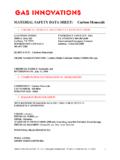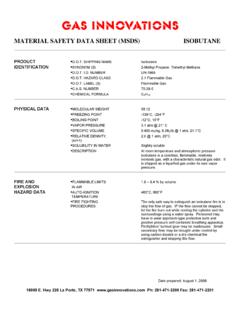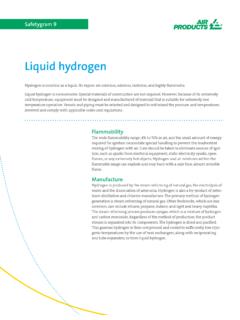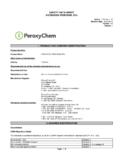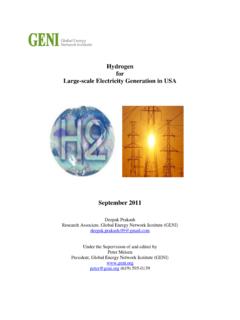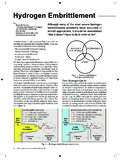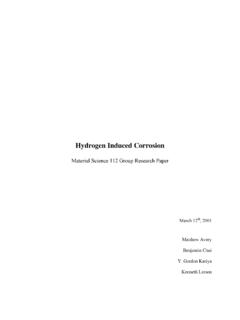Transcription of MSDS HYDROGEN CHLORIDE - Specialty Gas …
1 MATERIAL SAFETY DATA SHEET: HYDROGEN CHLORIDE . 1. CHEMICAL PRODUCT AND COMPANY IDENTIFICATION. GAS INNOVATIONS Emergency Contact: 18005 E. Hwy 225 3 E Company 866-303-2640. La Porte, TX 77571 Calls Originating Outside the US: Information: 281-471-2200 281-471-2200 (Collect Calls Accepted). SUBSTANCE: HYDROGEN CHLORIDE . TRADE NAMES/SYNONYMS: HYDROCHLORIC ACID, ANHYDROUS; HYDROGEN CHLORIDE ; SPIRITS OF SALT;. MURIATIC ACID; HYDROCHLORIC ACID; HYDROCHLORIC ACID GAS;. ANHYDROUS HYDROCHLORIC ACID; HYDROGEN CHLORIDE (HCl); UN 1050. CHEMICAL FAMILY: halogenated, gas CREATION DATE: Sept 20, 2009. REVISION DATE: Dec. 15, 2009. 2. COMPOSITION, INFORMATION ON INGREDIENTS. COMPONENT: HYDROGEN CHLORIDE . CAS NUMBER: 7647-01-0. PERCENTAGE: 100. 3. HAZARDS IDENTIFICATION. NFPA RATINGS (SCALE 0-4): HEALTH=3 FIRE=0 REACTIVITY=1. EMERGENCY OVERVIEW: COLOR: colorless PHYSICAL FORM: gas ODOR: irritating odor MAJOR HEALTH HAZARDS: respiratory tract burns, skin burns, eye burns, mucous membrane burns 18005 E.
2 Hwy 225 La Porte, TX 77571 Ph: 281-471-2200 Fax: 281-471-2201 Page: 1. PHYSICAL HAZARDS: Containers may rupture or explode if exposed to heat. May react on contact with water. POTENTIAL HEALTH EFFECTS: SHORT TERM EXPOSURE: burns LONG TERM EXPOSURE: burns 4. FIRST AID MEASURES. INHALATION: If adverse effects occur, remove to uncontaminated area. Give artificial respiration if not breathing. If breathing is difficult, oxygen should be administered by qualified personnel. Get immediate medical attention. SKIN CONTACT: Wash skin with soap and water for at least 15 minutes while removing contaminated clothing and shoes. Get immediate medical attention. Thoroughly clean and dry contaminated clothing and shoes before reuse. Destroy contaminated shoes. EYE CONTACT: Immediately flush eyes with plenty of water for at least 15 minutes. Then get immediate medical attention. INGESTION: Contact local poison control center or physician immediately. Never make an unconscious person vomit or drink fluids.
3 Give large amounts of water or milk. Allow vomiting to occur. When vomiting occurs, keep head lower than hips to help prevent aspiration. If person is unconscious, turn head to side. Get medical attention immediately. NOTE TO PHYSICIAN: For inhalation, consider oxygen. Avoid gastric lavage or emesis. 5. FIRE FIGHTING MEASURES. FIRE AND EXPLOSION HAZARDS: Negligible fire hazard. Containers may rupture or explode if exposed to heat. EXTINGUISHING MEDIA: carbon dioxide, regular dry chemical Large fires: Use regular foam or flood with fine water spray. FIRE FIGHTING: Do not get water inside container. Move container from fire area if it can be done without risk. Cool containers with water spray until well after the fire is out. Stay away from the ends of tanks. Keep unnecessary people away, isolate hazard area and deny entry. 18005 E. Hwy 225 La Porte, TX 77571 Ph: 281-471-2200 Fax: 281-471-2201 Page: 2. 6. ACCIDENTAL RELEASE MEASURES. AIR RELEASE: Reduce vapors with water spray. Stay upwind and keep out of low areas.
4 Collect runoff for disposal as potential hazardous waste. SOIL RELEASE: Dig holding area such as lagoon, pond or pit for containment. Dike for later disposal. Absorb with sand or other non-combustible material. Add an alkaline material (lime, crushed limestone, sodium bicarbonate, or soda ash). WATER RELEASE: Add an alkaline material (lime, crushed limestone, sodium bicarbonate, or soda ash). OCCUPATIONAL RELEASE: Stop leak if possible without personal risk. Reduce vapors with water spray. Do not get water directly on material. Do not get water inside container. Keep unnecessary people away, isolate hazard area and deny entry. Small spills: Flood with water. Large spills: Dike for later disposal. Stay upwind and keep out of low areas. Ventilate closed spaces before entering. Evacuation radius: 150 feet. Notify Local Emergency Planning Committee and State Emergency Response Commission for release greater than or equal to RQ. ( SARA Section 304). If release occurs in the and is reportable under CERCLA Section 103, notify the National Response Center at (800)424-8802 (USA) or (202)426-2675 (USA).
5 7. HANDLING AND STORAGE. STORAGE: Store and handle in accordance with all current regulations and standards. Store and handle in accordance with all current regulations and standards. Subject to storage regulations: OSHA 29 CFR Protect from physical damage. Store in a cool, dry place. Store in a well-ventilated area. Keep separated from incompatible substances. Keep separated from incompatible substances. Notify State Emergency Response Commission for storage or use at amounts greater than or equal to the TPQ ( EPA SARA Section 302). SARA Section 303 requires facilities storing a material with a TPQ to participate in local emergency response planning ( EPA 40 CFR ). Subject to storage regulations: OSHA 29 CFR Notify State Emergency Response Commission for storage or use at amounts greater than or equal to the TPQ ( EPA SARA Section 302). SARA Section 303. requires facilities storing a material with a TPQ to participate in local emergency response planning ( EPA 40 CFR ). Keep separated from incompatible substances.
6 HANDLING: Subject to handling regulations: OSHA 29 CFR 8. EXPOSURE CONTROLS, PERSONAL PROTECTION. EXPOSURE LIMITS: HYDROGEN CHLORIDE (HYDROCHLORIC ACID): 5 ppm (7 mg/m3) OSHA ceiling 2 ppm ACGIH ceiling 5 ppm (7 mg/m3) NIOSH recommended ceiling 18005 E. Hwy 225 La Porte, TX 77571 Ph: 281-471-2200 Fax: 281-471-2201 Page: 3. VENTILATION: Provide local exhaust or process enclosure ventilation system. Provide local exhaust or process enclosure ventilation system. Ensure compliance with applicable exposure limits. EYE PROTECTION: Wear splash resistant safety goggles with a faceshield. Provide an emergency eye wash fountain and quick drench shower in the immediate work area. CLOTHING: Wear appropriate chemical resistant clothing. GLOVES: Wear appropriate chemical resistant gloves. Wear appropriate chemical resistant gloves. RESPIRATOR: The following respirators and maximum use concentrations are drawn from NIOSH and/or OSHA. 50 ppm Any air-purifying half-mask respirator equipped with cartridge(s) providing protection against the compound of concern.
7 Any air-purifying full-facepiece respirator (gas mask) with a chin-style, front-mounted or back- mounted canister providing protection against the compound of concern. Any powered, air-purifying respirator with cartridge(s) providing protection against this substance. Any supplied-air respirator. Any self-contained breathing apparatus with a full facepiece. Emergency or planned entry into unknown concentrations or IDLH conditions. Any self-contained breathing apparatus that has a full facepiece and is operated in a pressure- demand or other positive-pressure mode. Any supplied-air respirator with a full facepiece that is operated in a pressure-demand or other positive-pressure mode in combination with an auxiliary self-contained breathing apparatus operated in pressure-demand or other positive-pressure mode. Escape Any air-purifying full-facepiece respirator (gas mask) with a chin-style, front-mounted or back- mounted acid gas canister. Any appropriate escape-type, self-contained breathing apparatus.
8 Under conditions of frequent use or heavy exposure, respiratory protection may be needed. Respiratory protection is ranked in order from minimum to maximum. Consider warning properties before use. For Unknown Concentrations or Immediately Dangerous to Life or Health Any supplied-air respirator with full facepiece and operated in a pressure-demand or other positive-pressure mode in combination with a separate escape supply. Any self-contained breathing apparatus with a full facepiece. 18005 E. Hwy 225 La Porte, TX 77571 Ph: 281-471-2200 Fax: 281-471-2201 Page: 4. 9. PHYSICAL AND CHEMICAL PROPERTIES. PHYSICAL STATE: gas COLOR: colorless ODOR: irritating odor MOLECULAR WEIGHT: MOLECULAR FORMULA: H-Cl BOILING POINT: -121 F (-85 C). FREEZING POINT: -175 F (-115 C). VAPOR PRESSURE: 30400 mmHg @ C. VAPOR DENSITY (air=1): SPECIFIC GRAVITY (water=1): @ -85 C. WATER SOLUBILITY: @ 0 C. PH: acidic in solution VOLATILITY: Not applicable ODOR THRESHOLD: 1-5 ppm EVAPORATION RATE: Not applicable COEFFICIENT OF WATER/OIL DISTRIBUTION: Not applicable SOLVENT SOLUBILITY: Soluble: alcohol, ether, benzene, methanol 10.
9 STABILITY AND REACTIVITY. REACTIVITY: May react with evolution of heat on contact with water. CONDITIONS TO AVOID: Minimize contact with material. Avoid inhalation of material or combustion by-products. Containers may rupture or explode if exposed to heat. INCOMPATIBILITIES: cyanides, metals, amines, bases, metal carbide, oxidizing materials, acids, halo carbons, combustible materials, halogens, metal salts HAZARDOUS DECOMPOSITION: Thermal decomposition products: chlorine POLYMERIZATION: Will not polymerize. 11. TOXICOLOGICAL INFORMATION. IRRITATION DATA: 5 mg/30 second(s) rinsed eyes-rabbit mild; 4 percent/24 hour(s) skin- human mild TOXICITY DATA: 3124 ppm/1 hour(s) inhalation-rat LC50; 900 mg/kg oral-rabbit LD50. CARCINOGEN STATUS: IARC: Human Inadequate Evidence, Animal Inadequate Evidence, Group 3; ACGIH: A4 -Not Classifiable as a Human Carcinogen 18005 E. Hwy 225 La Porte, TX 77571 Ph: 281-471-2200 Fax: 281-471-2201 Page: 5. LOCAL EFFECTS: Corrosive: inhalation, skin, eye, ingestion ACUTE TOXICITY LEVEL: Toxic: inhalation Moderately Toxic: ingestion MUTAGENIC DATA: Available.
10 REPRODUCTIVE EFFECTS DATA: Available. 12. ECOLOGICAL INFORMATION. ECOTOXICITY DATA: FISH TOXICITY: 21900 ug/L 96 hour(s) LC50 (Mortality) Fathead minnow (Pimephales promelas). INVERTEBRATE TOXICITY: 560 ug/L 48 hour(s) EC50 (Immobilization) Water flea (Daphnia magna). ALGAL TOXICITY: 800 ug/L 1600 week(s) EC50 (Population Size Reduction) Green algae (Chlorella pyrenoidosa). PHYTOTOXICITY: 1000 ug/L 4-48 week(s) (Residue) Water-hyacinth (Eichhornia crassipes). FATE AND TRANSPORT: BIOCONCENTRATION: 1000 M 24 week(s) BCF (Residue) Blue-green algae (Coccochloris sp) M. 13. DISPOSAL CONSIDERATIONS. Dispose in accordance with all applicable regulations. Subject to disposal regulations: EPA. 40 CFR 262. Hazardous Waste Number(s): D002. Dispose in accordance with all applicable regulations. 14. TRANSPORT INFORMATION. DOT 49 CFR : PROPER SHIPPING NAME: HYDROGEN CHLORIDE , anhydrous ID NUMBER: UN1050. HAZARD CLASS OR DIVISION: LABELING REQUIREMENTS: ; 8. QUANTITY LIMITATIONS: PASSENGER AIRCRAFT OR RAILCAR: Forbidden 18005 E.
